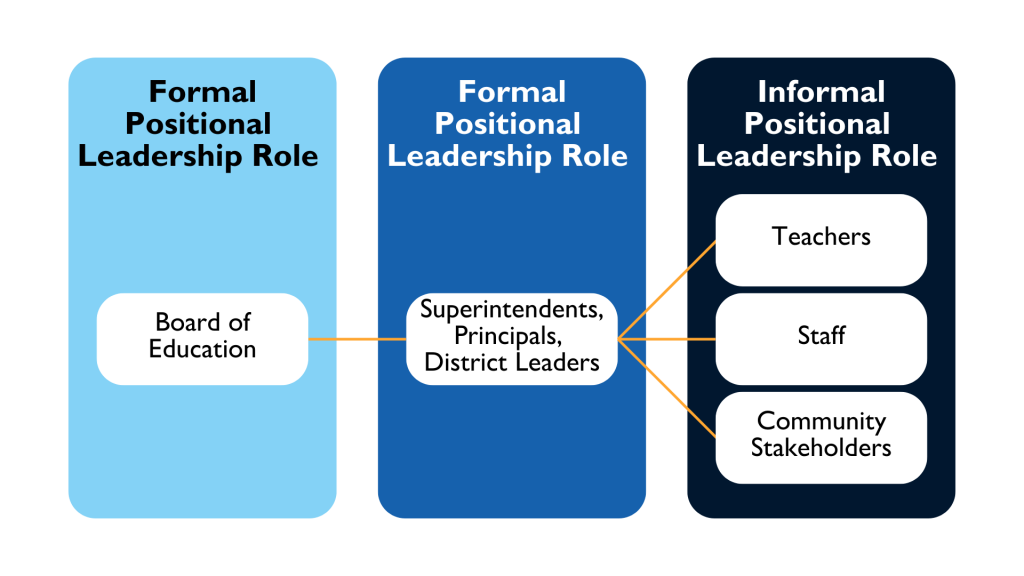I recently had the opportunity to spend some time at the Kansas Leadership Center (KLC) in Wichita. I always come away from my time there inspired and more determined to help school districts build cultures that foster leadership development at all levels of their system. The KLC has designed leadership principles and competencies that inspire individuals to embrace the messiness of leadership. Their first principle, “Leadership is an activity, not a position,” has always resonated with me when I reflect on all the actions in a school district requiring leadership from the lunchroom to the boardroom.
Unpacking this first principle makes a lot of sense when considering the complexities within a school district. The premise of the first principle is don’t wait for the positional leader to address the existing challenges. The principle makes sense, as in my experience, the people that best understand the issues surrounding the challenge are those closest to the challenge. Likely, someone from the upper echelons of positional leadership roles within a school district will not fully understand the complexities of the challenges in the classrooms and lunchrooms. Those closest to the challenge are likely best equipped to address it if they are willing to embrace the messiness of leading. Embracing that messiness is spurred by developing a supportive culture within the system that inspires those individuals to take the risk of leading. To create a supportive culture, the leadership actions displayed from the upper echelons of formal leadership positions must be the torch of inspiration to inspire others to take on the challenges. In contrast, at other times, the positional leaders must create and provide structures that push people to try something different.

Effective school board governance is critical in creating a culture that supports leadership action at all levels. The school board is the highest echelon of formal leadership within any school district. Building this culture starts with the school board being clear and consistent in their actions related to the school district’s Mission, Vision, and Goals. Clarity around the school district’s Mission/Vision,/Goals sets the direction for leaders within the system. This clear direction allows those closest to the challenges to have the confidence to respond and know their actions align with the school district’s overall direction. Those individuals experiencing the challenges daily don’t have to wait for the positional leader to swoop in and “solve” the problem with solutions that may not be sensitive to the complexities surrounding the challenge. Achieving clarity throughout the school district deepens the understanding of the work that must happen in the district to accomplish the Mission/Vision/Goals.
When the school board is consistent and clear with its Mission/Vision/Goals, it allows the next level of positional leaders within the district to best use their expertise and resources to support those engaged in defining how to address the challenges. The graphic above outlines examples of the formal positional leadership roles within a school district. A lack of clarity from the school board results in this level of positional leaders in the system ineffectively using time and resources. Inefficient use of resources and decisions made without connections to other work happening within the district causes the school district to suffer. A lack of clarity or inconsistent actions from the school board eliminates any overarching structure for accountability related to the use of resources and decision-making.
A clear Mission/Vision/Goal is also key to leaders understanding how to intervene and support stakeholders internally and externally as they begin to address challenges. As stakeholders start to engage in leadership to address the challenge, naturally, their embracing or adopting of the solutions will happen at a different pace. Some will jump in and succeed with the necessary actions to address the challenges, while others will be slower to adopt. I have written about leading change before, and if you recall, effectively leading systemic changes requires leadership from the positional leader and others throughout the system. Leadership is necessary at all levels because the individuals closest to the challenge will help those struggling to adopt solutions. Leaders at this level will enable other stakeholders to work through their struggles and ultimately succeed with the challenge. The personal struggles that stakeholders will experience typically fall into the following areas:
-
Feeling they do not have a voice or input into the solutions.
-
“New” solutions create a loss of consistent order or processes previously used.
-
Communication shared is not understood or unclear.
-
A deteriorating culture due to feelings of uncertainty in with the new culture.
Leaders at all levels can use their understanding of the Mission/Vision/Goals and personal success to provide the following type of support to those struggling:
-
Sharing how input was sought and utilized in the development of the solutions.
-
Give examples of how they have used the new processes to reestablish some semblance of order.
-
Interpreting communications and what the information means on a personal level.
-
Link new or current cultural expectations to past successes or foundational aspects of the previous culture
Leading is not for the meek. It is about addressing our most significant challenges. Education has a never-ending list of challenges that are difficult to handle for any leader at any level. These challenges cannot be addressed simply by the positional leaders of our systems but need to be discussed collectively by inspiring leadership at all levels within our system. When we establish a culture that develops and supports leadership at all system levels, our systems become more responsive to our most significant challenges. Our elected leaders and positional leaders must provide clarity around the school district’s Mission/Vision/Goals and then act consistently to live those Mission/Vision/Goals.
You can learn more about the KLC Leadership Principles and Competencies:
Your Leadership Edge: Strategies and Tools for When Everyone Leads, O’Malley and Cebula, 2015

 Additional settings for Safari Browser.
Additional settings for Safari Browser.



